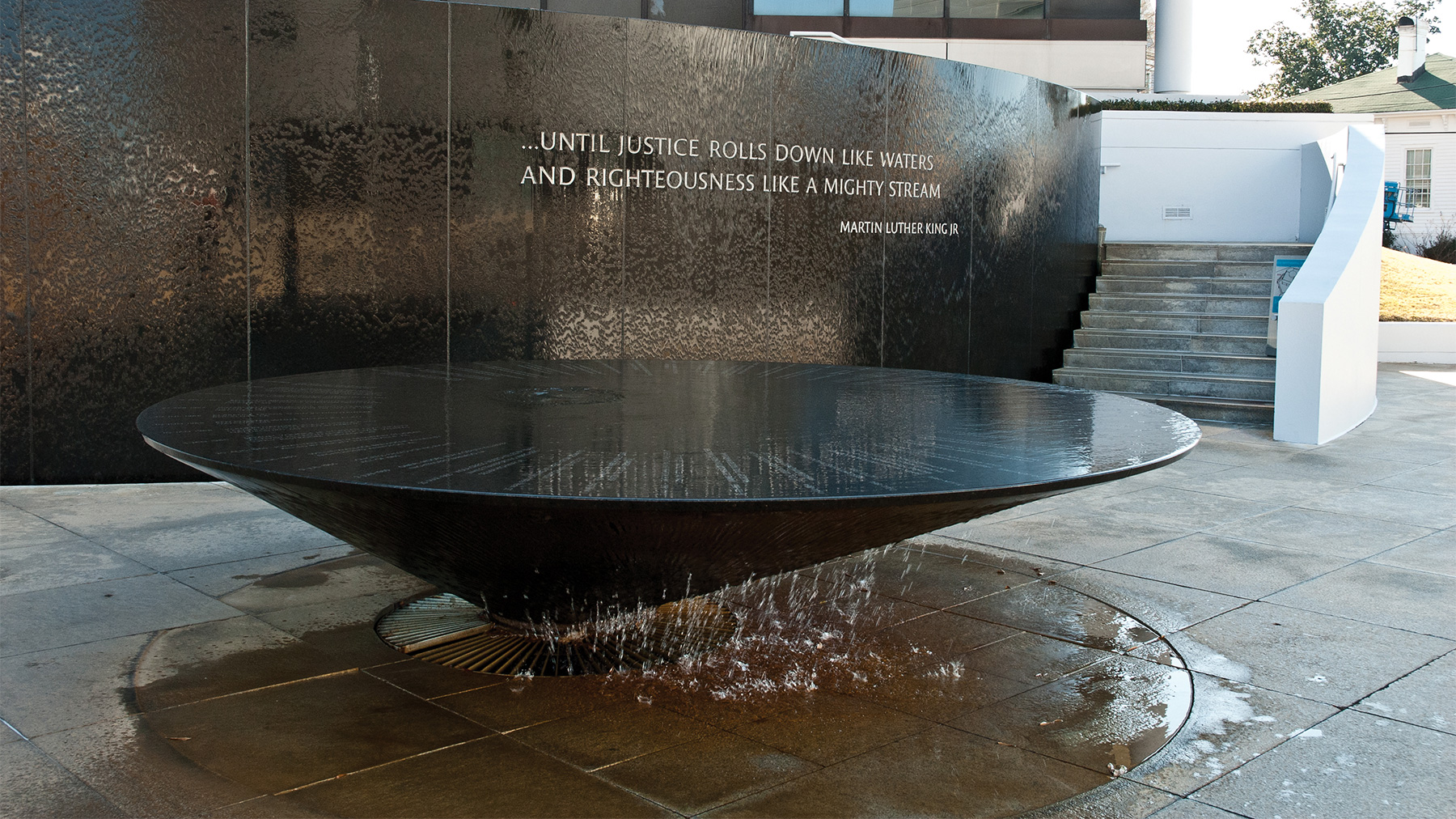Jimmie Lee Jackson was beaten and shot by Alabama state troopers during a peaceful voting rights march on Feb. 18, 1965.
His death prompted the Selma-to-Montgomery marches, including the “Bloody Sunday” march where troopers attacked nonviolent voting rights activists with clubs and tear gas. The beating at the Edmund Pettus Bridge, which was captured on national television, galvanized a movement that led to passage of the Voting Rights Act on Aug. 6, 1965.
As one of the martyrs of the movement, Jackson has his name engraved on the granite table of the Civil Rights Memorial in Montgomery, Alabama, along with 39 others who were killed during the movement.
That table, first installed 30 years ago, is being replaced today, on the 54th anniversary of the Voting Rights Act.
“The timing of the new memorial’s installation is perfect, not only because it lines up with the anniversary of the Voting Rights Act, but also because of where we are right now as a country with voter suppression,” said Tafeni English, director of the Civil Rights Memorial Center (CRMC). “It’s important that we keep fighting for voting rights in order to preserve democracy in our country.”
The memorial is just around the corner from the church where Martin Luther King Jr. served as pastor during the Montgomery Bus Boycott in 1955-1956, and the Alabama Capitol steps where the Selma-to-Montgomery march ended in 1965. It’s located on an open plaza accessible to visitors 24 hours a day, every day of the week.
Like the previous version, the new memorial is also designed by Maya Lin, creator of the Vietnam Veterans Memorial. The Civil Rights Memorial, which was originally unveiled on Nov. 5, 1989, invites visitors to touch the engraved names. As Lin envisioned, the memorial plaza is “a contemplative area – a place to remember the civil rights movement, to honor those killed during the struggle, to appreciate how far the country has come in its quest for equality, and to consider how far it has to go.”
Like the previous version of the memorial, the new one chronicles the history of the movement in lines that radiate like the hands of a clock. Water emerges from the new table’s center and flows evenly across the top, just like on the old one.
The newly installed, curved circular black granite table records exactly the same names that were on the previous one. But the names on the new version are more deeply ingrained in the table, making it easier for visitors to see them and run their fingers across them through the water.
In addition to King’s name – easily the most famous one on the table – other martyrs include Herbert Lee, whose family members visited the memorial last weekend, 30 years after their first visit when the memorial was unveiled.
Lee, who worked with civil rights leader Bob Moses to help register black voters, was shot and killed on Sept. 25, 1961, by a Mississippi state legislator who claimed self-defense and was never arrested. Louis Allen, a black man who witnessed the murder, was later also killed. His name is also on the memorial.
“Herbert Lee’s shooting was directly tied to the fact that he was encouraging people to vote, and the same goes for several other people whose names are listed on the memorial,” English said.
“They lost their lives pushing for the right for black people to vote in the Deep South.”
Today, the fight for voting rights continues.
In 2013, the U.S. Supreme Court’s ruling in the Shelby County v. Holder case weakened the Voting Rights Act. The ruling gutted a key provision of the Voting Rights Act that required places with a history of voter discrimination to get federal approval for any changes they make to voting rules.
In the years since that decision, lawmakers in numerous states have enacted laws that make it harder for citizens to vote.
Voter ID laws across various states today require voters to show a state-approved form of photo identification in order to vote. The laws discriminate against minority voters who are less likely to have such identification.
In Alabama, the epicenter of voting rights activism during the civil rights movement, the state has declined to implement reforms that could increase voter turnout, such as no-excuse absentee and early voting, which are commonly practiced in other parts of the country.
In November, almost 65 percent of Florida voters approved Amendment 4, which changed the state constitution to restore the right to vote to over 1.4 million Floridians who had completed their sentences for felony convictions. The amendment was widely celebrated all over the country for enfranchising the greatest number of people through a single law since the Voting Rights Act.
But a new law, Senate Bill 7066, requires people convicted of a crime to pay off all their fines and other financial obligations before regaining their voting rights. In July, the SPLC filed a federal lawsuit against Florida officials, claiming that the law is an unconstitutional, Jim Crow-like poll tax that discriminates against people based on their wealth and disparately impacts racial minorities.
Nancy Abudu, deputy legal director for voting rights at the SPLC, said the new Civil Rights Memorial’s installation, on the anniversary of the Voting Rights Act, demonstrates that the march for justice and equality continues.
“The struggle to protect voting rights in this country has been a long and bloody battle, but the spirit of these slain warriors lives on,’’ Abudu said. “The SPLC’s commitment to advancing voting rights is not only in honor of these brave Americans but hopefully will serve as the foundation for future generations because, in the words of Angela Davis, ‘Freedom is a constant struggle.’”



